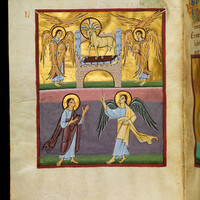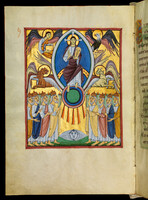Bamberg Apocalypse
Date:
ca. 1010
Location or Findspot (Modern-Day Country):
Germany
Medium:
Parchment
Dimensions:
29.5 × 20.5 cm
Description:
The Bamberg Apocalypse, named after the repository that now owns it, is an Ottonian manuscript containing, among other things, illustrations of the the book of Revelation (also called the Apocalypse). In the first miniature is a portrait of John, author of this final book of the New Testament, receiving his revelation from Christ in the form of a book.
The imagery of the Apocalypse is often perplexing and visionary in nature. John's vision of the four living creatures is illustrated with four evangelist symbols, each holding a book or scroll. They gaze upon Christ, who holds a scroll of his own and makes a gesture of blessing with his other hand. He sits on a jeweled rainbow and rests his feet on the sphere of the earth. At the bottom of the page, between two groups of crowned elders, is Oceanus, a personification of the sea of glass. In another visionary scene, John stands with his angelic guide at the bottom of the page, gesturing upwards to the Lamb of God with seven horns and seven eyes. The lamb stands on the book with seven seals, flanked by two seraphim.
Echoing the image of Christ seated on the jeweled rainbow is an image of the beardless Ottonian ruler (possibly Otto III or Henry II) seated between Peter and Paul, who place a crown on his head and thereby affirm his authority. In the register below, female personifications of earthly peoples present the ruler with bowls and cornucopias filled with precious stones.
Christianity and the Year 1000
According to the book of Genesis, the world was created in six days and God rested on the seventh; a related passage in the New Testament says that "With the Lord a day is like a thousand years and a thousand years are like a day" (2 Peter 3:8). These passages gave rise to the notion that six thousand years of human toil had to pass between Creation and the Second Coming of Christ, which would follow the appearance of the Antichrist and the Apocalypse described in the book of Revelation to usher in a new messianic era. Based on different early medieval calculations of the age of the world, Christ's return could occur in 500 or 801 CE. Beatus, writing his commentary a few decades before 800, believed that the return was imminent and convinced his followers to fast and wear sackcloth in preparation. Some people thought that Charlemagne's coronation in 800 would usher in the promised millennium.
When these events passed, and with a shift in the calendar in Latin Europe that dated events by years since the Incarnation of Christ instead of since Creation, predictions about when Christ would return began to fixate on the year 1000 or 1033. According to this view, the Second Coming would occur one thousand years after Christ's first appearance (in the putative year 0) or one thousand years after his death (in the year 33). Most clerical elites followed the view of St. Augustine and warned against assigning a specific year to the event, but many Western Christians anticipated that something special was going to happen in 1000 CE.
Beginning in the mid-tenth century, attacks by Norsemen and Magyars inspired treatises on the Antichrist and poems in Latin and vernacular languages about the end of the world. The Carolingian dynasty collapsed in 987, Halley's Comet appeared in 989, a great earthquake occurred during Holy Week of 1000, and apocalyptic fears were widespread. Rodulfus Glaber (985–1047), a monk at Cluny (France), the largest Benedictine monastery in Europe, chronicled numerous events that occurred around the pivotal year and that fulfilled, he thought, prophecies in Revelation (20:4–7): popular heresies, famines, a supernova (1003–6), and the destruction of the Holy Sepulcher. Yet once 1033 had passed, apocalyptic concerns did not disappear; instead, they spawned new forms of Christian religiosity in Europe: anti-Jewish violence, increasing pilgrimage to Jerusalem, the proliferation of relics, penitential processions, liturgical drama, and a new emphasis on Jesus's human nature—his working of miracles, suffering on the Cross, and such bodily relics as the holy foreskin and umbilicus.
The imagery of the Apocalypse is often perplexing and visionary in nature. John's vision of the four living creatures is illustrated with four evangelist symbols, each holding a book or scroll. They gaze upon Christ, who holds a scroll of his own and makes a gesture of blessing with his other hand. He sits on a jeweled rainbow and rests his feet on the sphere of the earth. At the bottom of the page, between two groups of crowned elders, is Oceanus, a personification of the sea of glass. In another visionary scene, John stands with his angelic guide at the bottom of the page, gesturing upwards to the Lamb of God with seven horns and seven eyes. The lamb stands on the book with seven seals, flanked by two seraphim.
Echoing the image of Christ seated on the jeweled rainbow is an image of the beardless Ottonian ruler (possibly Otto III or Henry II) seated between Peter and Paul, who place a crown on his head and thereby affirm his authority. In the register below, female personifications of earthly peoples present the ruler with bowls and cornucopias filled with precious stones.
Christianity and the Year 1000
According to the book of Genesis, the world was created in six days and God rested on the seventh; a related passage in the New Testament says that "With the Lord a day is like a thousand years and a thousand years are like a day" (2 Peter 3:8). These passages gave rise to the notion that six thousand years of human toil had to pass between Creation and the Second Coming of Christ, which would follow the appearance of the Antichrist and the Apocalypse described in the book of Revelation to usher in a new messianic era. Based on different early medieval calculations of the age of the world, Christ's return could occur in 500 or 801 CE. Beatus, writing his commentary a few decades before 800, believed that the return was imminent and convinced his followers to fast and wear sackcloth in preparation. Some people thought that Charlemagne's coronation in 800 would usher in the promised millennium.
When these events passed, and with a shift in the calendar in Latin Europe that dated events by years since the Incarnation of Christ instead of since Creation, predictions about when Christ would return began to fixate on the year 1000 or 1033. According to this view, the Second Coming would occur one thousand years after Christ's first appearance (in the putative year 0) or one thousand years after his death (in the year 33). Most clerical elites followed the view of St. Augustine and warned against assigning a specific year to the event, but many Western Christians anticipated that something special was going to happen in 1000 CE.
Beginning in the mid-tenth century, attacks by Norsemen and Magyars inspired treatises on the Antichrist and poems in Latin and vernacular languages about the end of the world. The Carolingian dynasty collapsed in 987, Halley's Comet appeared in 989, a great earthquake occurred during Holy Week of 1000, and apocalyptic fears were widespread. Rodulfus Glaber (985–1047), a monk at Cluny (France), the largest Benedictine monastery in Europe, chronicled numerous events that occurred around the pivotal year and that fulfilled, he thought, prophecies in Revelation (20:4–7): popular heresies, famines, a supernova (1003–6), and the destruction of the Holy Sepulcher. Yet once 1033 had passed, apocalyptic concerns did not disappear; instead, they spawned new forms of Christian religiosity in Europe: anti-Jewish violence, increasing pilgrimage to Jerusalem, the proliferation of relics, penitential processions, liturgical drama, and a new emphasis on Jesus's human nature—his working of miracles, suffering on the Cross, and such bodily relics as the holy foreskin and umbilicus.
Relevant Textbook Chapter(s):
6




